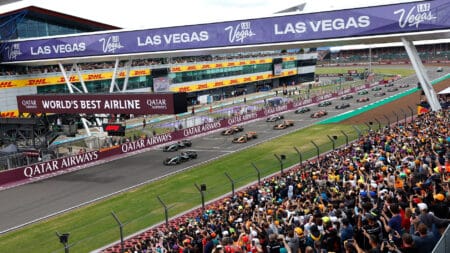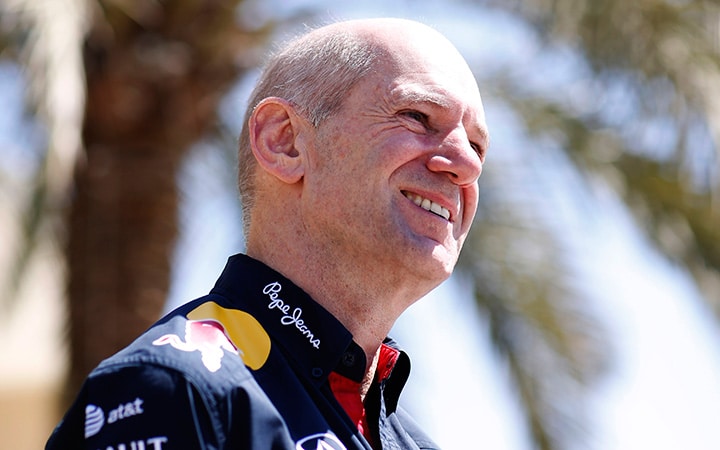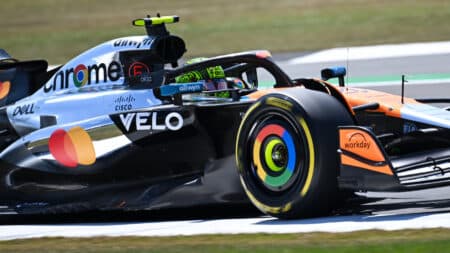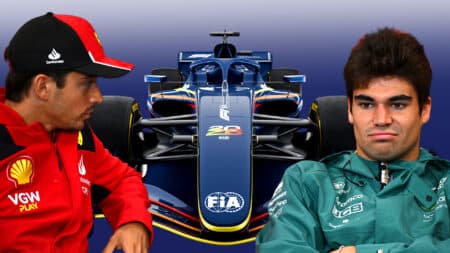
Tomorrow's F1 starting grid for the 2025 British Grand Prix
Max Verstappen will start on pole for the 2025 British Grand Prix after a brilliant last gasp qualifying lap. Here's how the starting grid looks for Sunday's race at Silverstone

Adrian Newey packages his thoughts into words in much the same way he draws perfectly formed Grand Prix cars: there’s not an ounce of wastage, everything is expressed tidily and always for a specific reason – and he can’t help adding a touch of flair.
Take his pay-off line in our cover story for the September issue of Motor Sport. In summing up his disenchantment with Formula 1 and its ever-restrictive rulebook, he says: “I must say, my fellow F1 technical directors have been like turkeys voting for Christmas.”
Words patently not minced.
Newey is about to retire from F1 after a career in which he has stamped his mark on the sport like no other. Probably only Rory Byrne rivals his influence and astonishing success over the past 25 years or so.
There were world titles at Williams for Nigel Mansell, Alain Prost, Damon Hill and Jacques Villeneuve; two more at McLaren with Mika Häkkinen; and perhaps most remarkably a string of four with Red Bull and Sebastian Vettel, having turned a grossly underperforming team into the best and most efficient on the grid. Yes, he had the budget to do it, but as modern-day Ferrari shows only too clearly, money is never enough to guarantee success.
Is Newey the greatest racing car designer in history? As with drivers, comparing era to era has its complications and might well be futile. But the sheer number of wins, over the course of more than a quarter of a century, puts him safely in the company of Jano, Uhlenhaut, Chapman, Murray and their ilk.
That he’s leaving F1 while still young enough to achieve so much more could be considered an indictment of what the sport has become. On the back of the past five Grands Prix, it seems churlish to damn F1 when the racing has been so gripping. But for a purist such as Newey – which he undoubtedly is – Grand Prix racing has lost its way, however compelling the spectacle might be.

“There have been a whole host of factors playing their parts in my decision to leave F1, and a lot of mixed emotions,” he tells us in the magazine. “I felt it was time to challenge myself in something different and that’s certainly a factor. But at the same time I do think the regs have become too restrictive. We’re in danger, chassis-wise, of becoming GP1. Everybody’s converging on cars that look more and more similar. We’re back to ‘paint the cars white and it’s difficult to spot the difference’ – especially next year when we even lose the different noses.”
Adrian Newey’s top six F1 cars by Mark Hughes
Lunch with Perry McCarthy by Simon Taylor
Le Mans Classic road trip by Rob Widdows
Brett Lunger interview by Andrew Marriott
The single-seater ladder by Simon Arron
Prince Michael interview by Gordon Cruickshank
750 Motor Club group test by Ed Foster
Bluebird: 50 years on by James Nicholls
1924 French GP retrospective by Paul Fearnley
Now, it’s one thing for us all to say it, but when a man who thinks in a way we can barely imagine pulls that line, you know it’s more than just a cliché.
Newey admits F1 has again become “an engine formula”, as it was when he first came in with March in the late 1980s. Therefore it doesn’t play to his aero strengths and with the confines he must now work in, he’s clearly not going to like it. Without him, F1 will go on, and on the evidence of 2014 perhaps with a generation of cars that inspire better racing than we saw through most of his era.
But will we miss him? Surely, yes. Just as when great drivers walk away, he’ll leave a hole that will be tough – in his case perhaps impossible – to fill. Newey is an independent spirit, one of life’s great free thinkers, and ruthlessly competitive in the same mould as those who came before him. How can we not miss a man like that?

Elsewhere in the September issue, we bring you stories from other areas of the sport, including the historic scene and Le Mans. This month past I travelled back to La Sarthe, three weeks after the 24 Hours, to experience the biennial Classic meeting for the first time.
The event, on the same weekend as the British Grand Prix, left me with mixed feelings. The huge grids of cars were diverse and spectacular in their quality, but too often the racing failed to engage with the audience. Old cars on modern circuits, which Le Mans now is, don’t always work thanks to the distance created between crowds and the action by large run-off areas. At the Le Mans, the problem was enhanced by the organisers’ apparent lack of effort to tell the story of what was going on around the full 8.4 miles of the track.
My impression was of a race meeting that has all fabulous elements you might crave, but they’re not yet all working together to consistently deliver the magic of a Goodwood Revival.
The journey down to Le Mans and back again was, for me, more memorable and captured the clash of old and new that we constantly seem to experience at Motor Sport. The loan of a Ferrari F12 gave me a taste of what modern Grand Touring can mean, especially on France’s smooth and uncluttered roads (relative to the south of England).

The F12, with its 700bhp 6.3-litre V12, sophisticated electronics, firm but sympathetic ride and refined aerodynamic grip, is a stylish amalgam of everything the car can be in 2014. I found it almost impossible to fault.
But as we pieced this issue together, I find myself asking: would I have preferred to be in Rob Widdows’ shoes, as he joined Bentley motor sport boss Brian Gush in a blast down to La Sarthe in Birkin’s ‘Blower’ Bentley? Hmm. The comfort and performance of the Ferrari – benign when you need it to be, dumbfoundingly monstrous when you want it to be – would be hard to walk away from. But I’d have to say yes, the 1930 Bentley would pull me towards it (although only if I was ‘Birkin’ and not ‘riding mechanic’!).
As usual, it comes down to spirit and character. For a modern car, the Ferrari has plenty – but for sheer joy and freedom from the constraints that are part of modern life, the raw vitality of the old ‘Blower’ is hard to beat.
Adrian Newey would understand.

Max Verstappen will start on pole for the 2025 British Grand Prix after a brilliant last gasp qualifying lap. Here's how the starting grid looks for Sunday's race at Silverstone

Austrian GP winner Norris went quickest at Silverstone during the Friday F1 practice sessions ahead of the 2025 British Grand Prix

Lewis Hamilton hadn't won in almost three years – and then produced a sensational victory at Silverstone 2024. James Elson explains why it was his best ever

As more drivers get a feel for the 2026 Formula 1 cars in simulators, concern is growing that the new regulations may sacrifice driving enjoyment in pursuit of technical ambition, as Mark Hughes reports